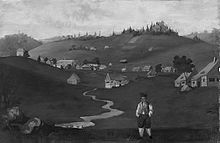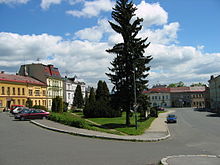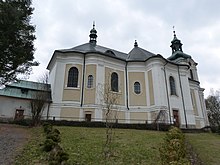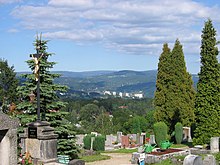Smržovka
| Smržovka | ||||
|---|---|---|---|---|
|
||||
| Basic data | ||||
| State : |
|
|||
| Region : | Liberecký kraj | |||
| District : | Jablonec nad Nisou | |||
| Area : | 1481.491 ha | |||
| Geographic location : | 50 ° 44 ' N , 15 ° 15' E | |||
| Height: | 585 m nm | |||
| Residents : | 3,751 (Jan 1, 2019) | |||
| Postal code : | 468 51 | |||
| License plate : | L. | |||
| traffic | ||||
| Railway connection: |
Liberec – Tanvald Smržovka – Josefův Důl |
|||
| structure | ||||
| Status: | city | |||
| Districts: | 1 | |||
| administration | ||||
| Mayor : | Marek Hotovec (as of 2007) | |||
| Address: | náměstí TG Masaryka 600 468 51 Smržovka |
|||
| Municipality number: | 563811 | |||
| Website : | www.smrzovka.cz | |||
Smržovka (German Morchenstern , formerly also Morchelstern and Morgenstern ) is a town with about 3500 inhabitants in Liberecký kraj in the Czech Republic and belongs to the Neisse Euroregion .
Geographical location
.
The city is located in northern Bohemia in the Jizera Mountains , about 10 km east of the district town of Jablonec nad Nisou (German Gablonz an der Neisse ).
history
The settlement was first mentioned in 1568 and initially belonged to the Smiřický family. From 1622 it was owned by Albrecht von Wallenstein . From 1634 the Morchenstern reign belonged to the Count Desfours . In the 18th century, the rule was inherited from Count Franz Anton Desfours, who still owned it around 1785. The village of Morchenstern had 333 houses at this time.
Michaelskirche, which Count Nikolaus Desfours had first built out of wood in 1735, was elevated to a parish church in 1749 and rebuilt in 1766 by Count Karl Josef Desfours on the plan of a cross, large and beautiful, and with the bells of the repealed St. Michael Church Prague gifts.
For a long time Smržovka was a center of the wood industry, from the 18th century also the textile and glass industry. From the middle of the 19th century, the village formed a municipality in the judicial district of Tannwald . In 1868 the place officially became a market town and in 1905 it received city rights .
After the First World War , Morchenstern was added to the newly created Czechoslovakia . Due to the Munich Agreement , Morchenstern belonged from 1938 to 1945 to the district of Gablonz an der Neisse , district of Aussig , in the Reichsgau Sudetenland of the German Empire .
Up until the Second World War , the city was predominantly inhabited by Germans, some of whom were expelled in 1945 and others who stayed there as specialists. In Morchenstern there was a forced labor camp for women from the Groß-Rosen concentration camp from 1944 until the end of the war .
Demographics
Until 1945 Morchenstern was predominantly populated by German Bohemia , which were expelled.
| year | Residents | Remarks |
|---|---|---|
| 1830 | 2550 | in 471 houses |
| 1900 | 6942 | German residents |
| 1930 | 7846 | |
| 1939 | 6703 |
| year | 1970 | 1980 | 1991 | 2001 | 2003 | 2006 |
|---|---|---|---|---|---|---|
| Residents | 3747 | 3526 | 3418 | 3430 | 3433 | 3431 |
etymology
Smržovka is derived from the adjective smržová, which means a mountain with a forest in which many morels grow. The German settlers misinterpreted this and assumed the medieval weapon as the namesake. To this day, the morel and two stars are included in the coat of arms as symbols for the morning star.
The official German name for Smržovka is Morchenstern . The German name is a bit controversial among the population, because until around 1970 Morchelstern was the common German name. The morel is often found in the mountainous region Jizera.
Community structure
No districts are designated for Smržovka. Basic settlement units are Dolní Smržovka (Lower Morch Star ) , Horní Ves, Luční, Muchovský hřeben, Nová Mýtina, Střední Smržovka (Middle Morch Star ) , Zaertrí and Záhoří.
economy
The glass cutting is a tradition in the village; “Gablonzer Bijouterie ” was and is produced in large quantities by hand in Smržovka and the neighboring village of Tanvald, mainly in family grinding shops. There is a toboggan run with natural ice in Smržovka.
There is a Czech-German meeting center in the city.
Personalities
- Gerd Zimmermann (1924–2013), historian
- Petr Urban (* 1960), luge rider, caricaturist (ran a restaurant in the village where his works can be seen on walls and ceilings)
- Petra Kaprasová (* 1971), luge rider
- Jakub Hyman (* 1984), luge rider
- Lukáš Brož (* 1985), luge rider
- Antonín Brož (* 1987), luge rider
- Tomáš Dočekal (* 1989), football player
Parish partnership
- Weidenberg (Germany), since 1998
Web links
Individual evidence
- ↑ http://www.uir.cz/obec/563811/Smrzovka
- ↑ Český statistický úřad - The population of the Czech municipalities as of January 1, 2019 (PDF; 7.4 MiB)
- ↑ a b Jaroslaus Schaller : Topography of the Kingdom of Bohemia . Volume 4: Bunzlauer Kreis , Prague 1786, pp. 301-303.
- ^ A b Johann Gottfried Sommer : The Kingdom of Bohemia . Volume 2: Bunzlauer Kreis , Prague 1834, p. 324, item 1).
- ^ Rudolf M. Wlaschek: Jews in Böhmen . Munich: Oldenbourg, 1990, p. 152
- ^ Meyer's Large Conversational Lexicon . 6th edition, Volume 14, Leipzig and Vienna 1908, p. 135 .
- ^ A b Michael Rademacher: German administrative history from the unification of the empire in 1871 to the reunification in 1990. Gablonz district on the Neisse. (Online material for the dissertation, Osnabrück 2006).
- ↑ Czech population statistics
- ^ City of Smržovka: History
- ↑ http://www.uir.cz/zsj-obec/563811/Obec-Smrzovka






